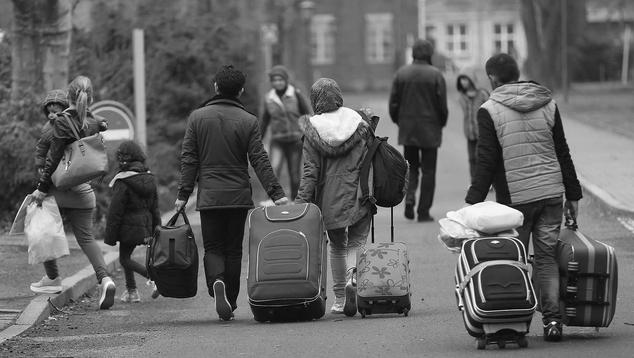Most migrants around the world would like to stay where they are, and few would like to move again -- and if they did, very few would like to move back home. Gallup finds this is true of migrants living in every part of the world. However, a new analysis shows that these desires depend largely on where migrants are living now, where they came from and what their lives are like in their adopted countries.
| Migrants who want to stay | Migrants who want to move to another country | Migrants who want to move home | |||||||||||||||||||||||||||||||||||||||||||||||||||||||||||||||||||||||||||||||||||||||||||||||||
|---|---|---|---|---|---|---|---|---|---|---|---|---|---|---|---|---|---|---|---|---|---|---|---|---|---|---|---|---|---|---|---|---|---|---|---|---|---|---|---|---|---|---|---|---|---|---|---|---|---|---|---|---|---|---|---|---|---|---|---|---|---|---|---|---|---|---|---|---|---|---|---|---|---|---|---|---|---|---|---|---|---|---|---|---|---|---|---|---|---|---|---|---|---|---|---|---|---|---|---|
| Sub-Saharan Africa | 64 | 28 | 8 | ||||||||||||||||||||||||||||||||||||||||||||||||||||||||||||||||||||||||||||||||||||||||||||||||
| European Union | 69 | 22 | 9 | ||||||||||||||||||||||||||||||||||||||||||||||||||||||||||||||||||||||||||||||||||||||||||||||||
| Latin America and the Caribbean | 71 | 17 | 13 | ||||||||||||||||||||||||||||||||||||||||||||||||||||||||||||||||||||||||||||||||||||||||||||||||
| Middle East and North Africa | 74 | 19 | 7 | ||||||||||||||||||||||||||||||||||||||||||||||||||||||||||||||||||||||||||||||||||||||||||||||||
| Europe-Other | 78 | 16 | 7 | ||||||||||||||||||||||||||||||||||||||||||||||||||||||||||||||||||||||||||||||||||||||||||||||||
| Commonwealth of Independent States | 81 | 14 | 6 | ||||||||||||||||||||||||||||||||||||||||||||||||||||||||||||||||||||||||||||||||||||||||||||||||
| Northern America | 85 | 11 | 4 | ||||||||||||||||||||||||||||||||||||||||||||||||||||||||||||||||||||||||||||||||||||||||||||||||
| Rest of Asia | 86 | 13 | 2 | ||||||||||||||||||||||||||||||||||||||||||||||||||||||||||||||||||||||||||||||||||||||||||||||||
| Australia-New Zealand | 88 | 9 | 4 | ||||||||||||||||||||||||||||||||||||||||||||||||||||||||||||||||||||||||||||||||||||||||||||||||
| Gallup World Poll, 2010-2018 | |||||||||||||||||||||||||||||||||||||||||||||||||||||||||||||||||||||||||||||||||||||||||||||||||||
Like other migrants around the world, the majority of migrants living in sub-Saharan Africa still want to stay in their adopted countries. However, the 64% of migrants who want to stay is the lowest percentage in the world, and the 28% who would like to move somewhere else (except home) is the highest in the world. Just 8% would like to move home.
While these numbers may not be that surprising, interestingly enough, the numbers in sub-Saharan Africa aren't that much different among migrants in the European Union. Sixty-nine percent of migrants living in the EU would like to stay where they are, while 22% would like to move to another country and a much smaller 9% would like to move home.
The common thread that ties both of these seemingly disparate regions together is that they are both home to substantial intraregional migration. However, there are big differences in where migrants in these regions would like to move to. The majority of migrants in the EU would like to move to another EU country and the majority of migrants who live in sub-Saharan Africa want to leave the region and go to Northern America or Western Europe.
Northern America and Australia-New Zealand -- both high-receiving regions for migrants with lower percentages of intraregional migration -- are on the other end of the spectrum. The percentages of migrants who want to stay are the highest in the world, and extremely few want to move home.
"Thriving" Doesn't Equal "Staying"
At the global level, migrants who want to remain in their adopted country (40%) are more likely to rate their lives positively enough to be considered "thriving" than those who want to go home (37%) or move to another country (30%). However, the global numbers mask some interesting regional differences.
| Thriving | Suffering | |||||||||||||||||||||||||||||||||||||||||||||||||||||||||||||||||||||||||||||||||||||||||||||||||||
|---|---|---|---|---|---|---|---|---|---|---|---|---|---|---|---|---|---|---|---|---|---|---|---|---|---|---|---|---|---|---|---|---|---|---|---|---|---|---|---|---|---|---|---|---|---|---|---|---|---|---|---|---|---|---|---|---|---|---|---|---|---|---|---|---|---|---|---|---|---|---|---|---|---|---|---|---|---|---|---|---|---|---|---|---|---|---|---|---|---|---|---|---|---|---|---|---|---|---|---|---|
| % | % | |||||||||||||||||||||||||||||||||||||||||||||||||||||||||||||||||||||||||||||||||||||||||||||||||||
| Australia-New Zealand | ||||||||||||||||||||||||||||||||||||||||||||||||||||||||||||||||||||||||||||||||||||||||||||||||||||
| Migrants who want to stay | 62 | 2 | ||||||||||||||||||||||||||||||||||||||||||||||||||||||||||||||||||||||||||||||||||||||||||||||||||
| Migrants who want to move to another country | 56 | 2 | ||||||||||||||||||||||||||||||||||||||||||||||||||||||||||||||||||||||||||||||||||||||||||||||||||
| Migrants who want to move home | 50 | 5 | ||||||||||||||||||||||||||||||||||||||||||||||||||||||||||||||||||||||||||||||||||||||||||||||||||
| European Union | ||||||||||||||||||||||||||||||||||||||||||||||||||||||||||||||||||||||||||||||||||||||||||||||||||||
| Migrants who want to stay | 39 | 7 | ||||||||||||||||||||||||||||||||||||||||||||||||||||||||||||||||||||||||||||||||||||||||||||||||||
| Migrants who want to move to another country | 30 | 10 | ||||||||||||||||||||||||||||||||||||||||||||||||||||||||||||||||||||||||||||||||||||||||||||||||||
| Migrants who want to move home | 34 | 9 | ||||||||||||||||||||||||||||||||||||||||||||||||||||||||||||||||||||||||||||||||||||||||||||||||||
| Gulf Cooperation Council | ||||||||||||||||||||||||||||||||||||||||||||||||||||||||||||||||||||||||||||||||||||||||||||||||||||
| Migrants who want to stay | 42 | 3 | ||||||||||||||||||||||||||||||||||||||||||||||||||||||||||||||||||||||||||||||||||||||||||||||||||
| Migrants who want to move to another country | 37 | 4 | ||||||||||||||||||||||||||||||||||||||||||||||||||||||||||||||||||||||||||||||||||||||||||||||||||
| Migrants who want to move home | 36 | 5 | ||||||||||||||||||||||||||||||||||||||||||||||||||||||||||||||||||||||||||||||||||||||||||||||||||
| Gallup World Poll, 2010-2018 | ||||||||||||||||||||||||||||||||||||||||||||||||||||||||||||||||||||||||||||||||||||||||||||||||||||
The relationship between thriving and migrants' desire to stay or move largely follows the global pattern in some of the top receiving regions for migrants. In top-destination regions such as Australia-New Zealand, the EU and Gulf Cooperation Council countries, the less likely migrants are to be thriving, the less likely they are to want to stay in their current country.
But in a host of other regions, including the Commonwealth of Independent States, Latin America and the Caribbean, and the Middle East and North Africa (excluding GCC), these same patterns don't play out.
| Thriving | Suffering | |||||||||||||||||||||||||||||||||||||||||||||||||||||||||||||||||||||||||||||||||||||||||||||||||||
|---|---|---|---|---|---|---|---|---|---|---|---|---|---|---|---|---|---|---|---|---|---|---|---|---|---|---|---|---|---|---|---|---|---|---|---|---|---|---|---|---|---|---|---|---|---|---|---|---|---|---|---|---|---|---|---|---|---|---|---|---|---|---|---|---|---|---|---|---|---|---|---|---|---|---|---|---|---|---|---|---|---|---|---|---|---|---|---|---|---|---|---|---|---|---|---|---|---|---|---|---|
| % | % | |||||||||||||||||||||||||||||||||||||||||||||||||||||||||||||||||||||||||||||||||||||||||||||||||||
| Commonwealth of Independent States | ||||||||||||||||||||||||||||||||||||||||||||||||||||||||||||||||||||||||||||||||||||||||||||||||||||
| Migrants who want to stay | 25 | 18 | ||||||||||||||||||||||||||||||||||||||||||||||||||||||||||||||||||||||||||||||||||||||||||||||||||
| Migrants who want to move to another country | 22 | 17 | ||||||||||||||||||||||||||||||||||||||||||||||||||||||||||||||||||||||||||||||||||||||||||||||||||
| Migrants who want to move home | 22 | 28 | ||||||||||||||||||||||||||||||||||||||||||||||||||||||||||||||||||||||||||||||||||||||||||||||||||
| Latin America and Caribbean | ||||||||||||||||||||||||||||||||||||||||||||||||||||||||||||||||||||||||||||||||||||||||||||||||||||
| Migrants who want to stay | 41 | 10 | ||||||||||||||||||||||||||||||||||||||||||||||||||||||||||||||||||||||||||||||||||||||||||||||||||
| Migrants who want to move another country | 37 | 7 | ||||||||||||||||||||||||||||||||||||||||||||||||||||||||||||||||||||||||||||||||||||||||||||||||||
| Migrants who want to move home | 42 | 7 | ||||||||||||||||||||||||||||||||||||||||||||||||||||||||||||||||||||||||||||||||||||||||||||||||||
| Middle East and North Africa (Excluding GCC) | ||||||||||||||||||||||||||||||||||||||||||||||||||||||||||||||||||||||||||||||||||||||||||||||||||||
| Migrants who want to stay | 19 | 21 | ||||||||||||||||||||||||||||||||||||||||||||||||||||||||||||||||||||||||||||||||||||||||||||||||||
| Migrants who want to move to another country | 19 | 23 | ||||||||||||||||||||||||||||||||||||||||||||||||||||||||||||||||||||||||||||||||||||||||||||||||||
| Migrants who want move home | 27 | 9 | ||||||||||||||||||||||||||||||||||||||||||||||||||||||||||||||||||||||||||||||||||||||||||||||||||
| Gallup World Poll, 2010-2018 | ||||||||||||||||||||||||||||||||||||||||||||||||||||||||||||||||||||||||||||||||||||||||||||||||||||
For example, migrants in the CIS who rate their lives poorly enough to be classified as "suffering" are the most likely to want to move home. Migrants in MENA (excluding the GCC) who rate their lives positively enough to be classified as "thriving" are more likely to want to move home than if they are "suffering." So, in one case, people are doing poorly and want to go home, and in the other, they are doing well and want to do the same thing.
Implications
People's desire to migrate depends on where they live now, what their lives are like in their adopted countries and what the situations are like back in their countries of birth. But differences by region and by people's life evaluations underscore the complexity behind the reasons why migrants might want to stay or to keep moving. There is no one-size-fits-all approach to understanding them all, which is why Gallup will continue digging deeper into the phenomenon with additional analyses of these attitudes at the country level.




